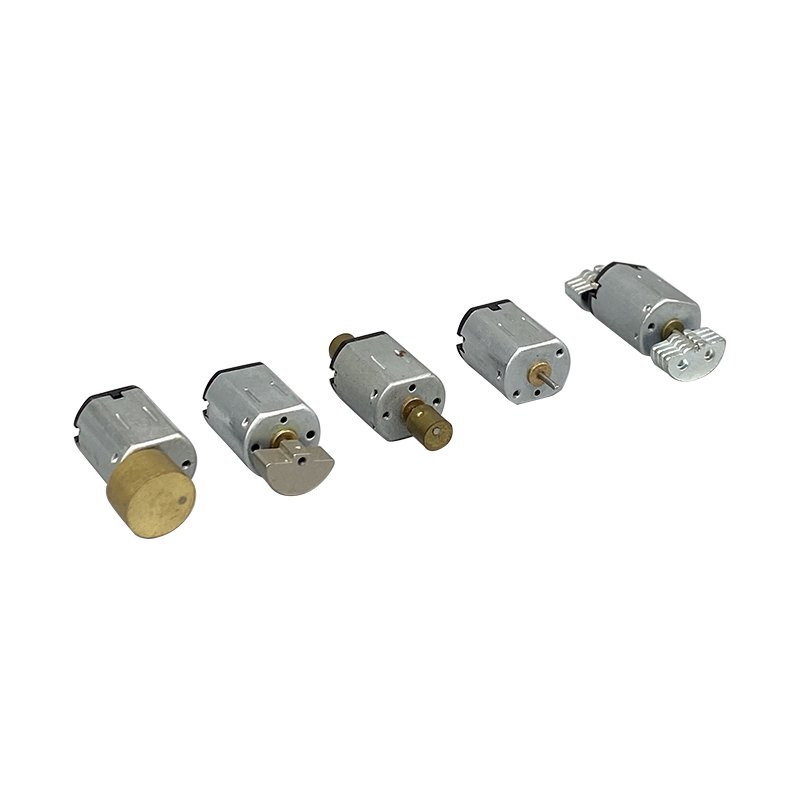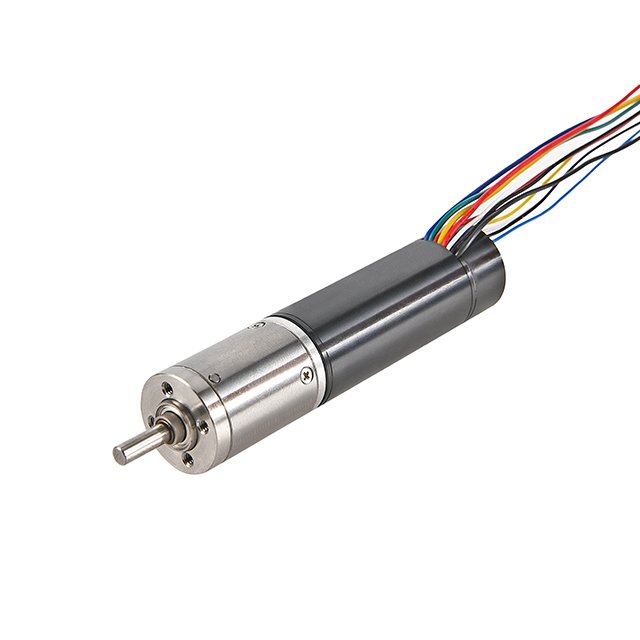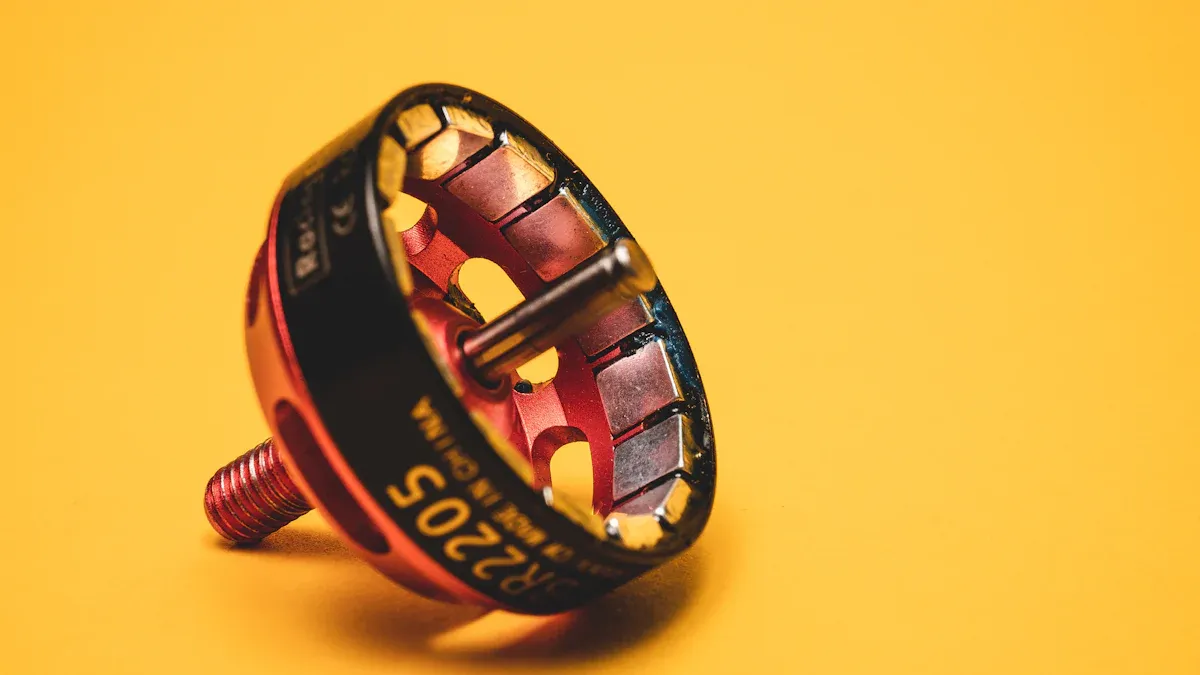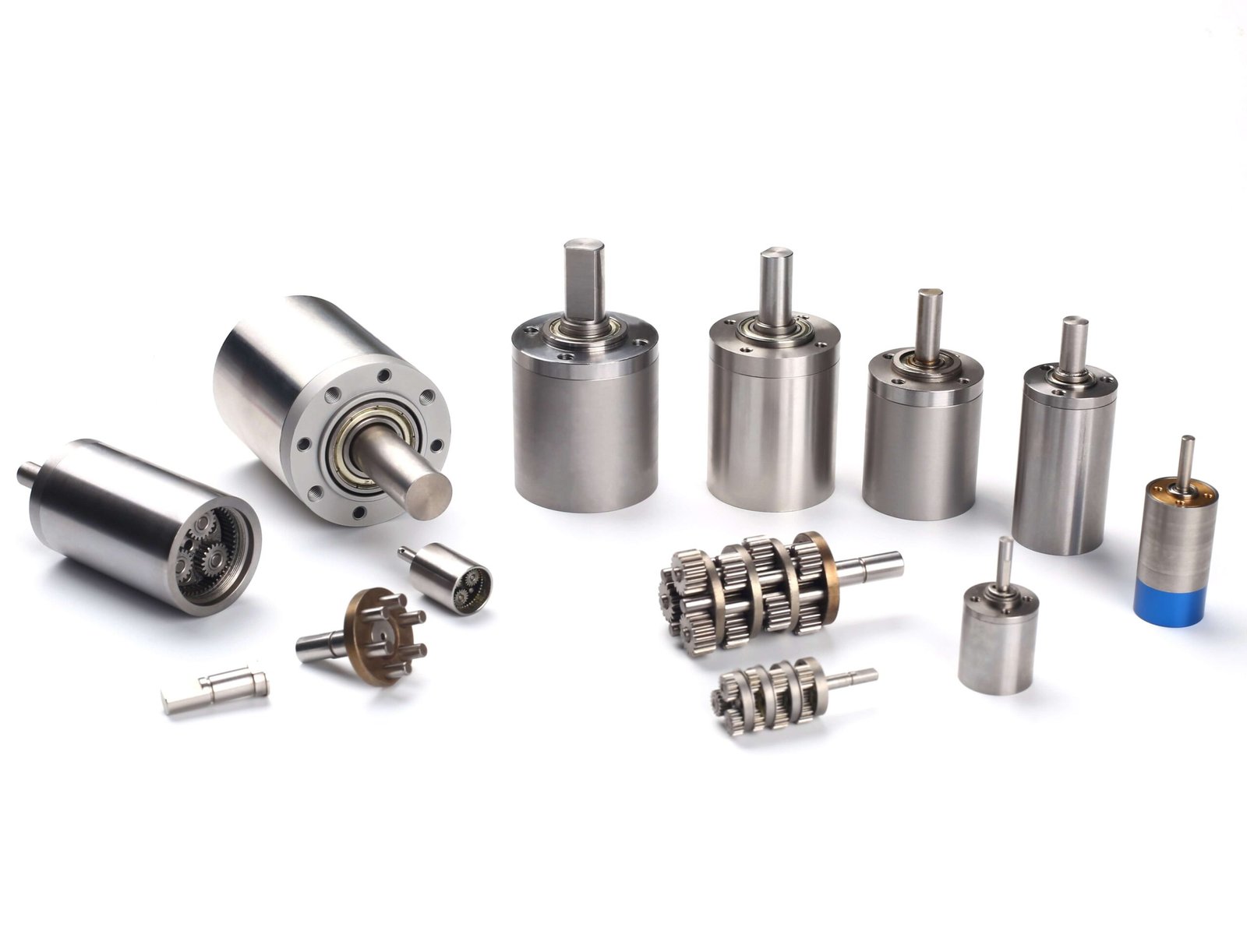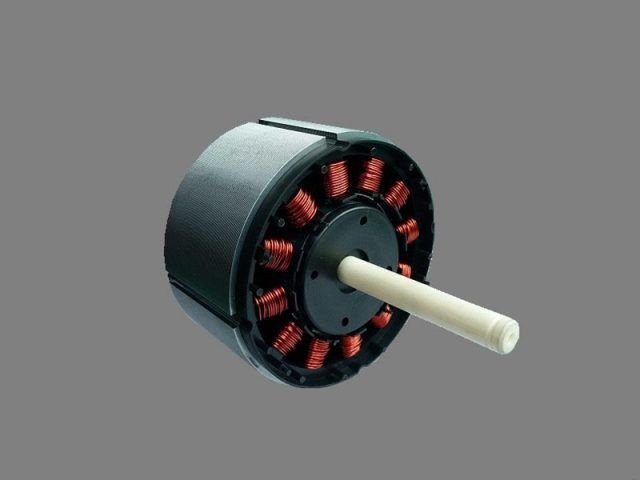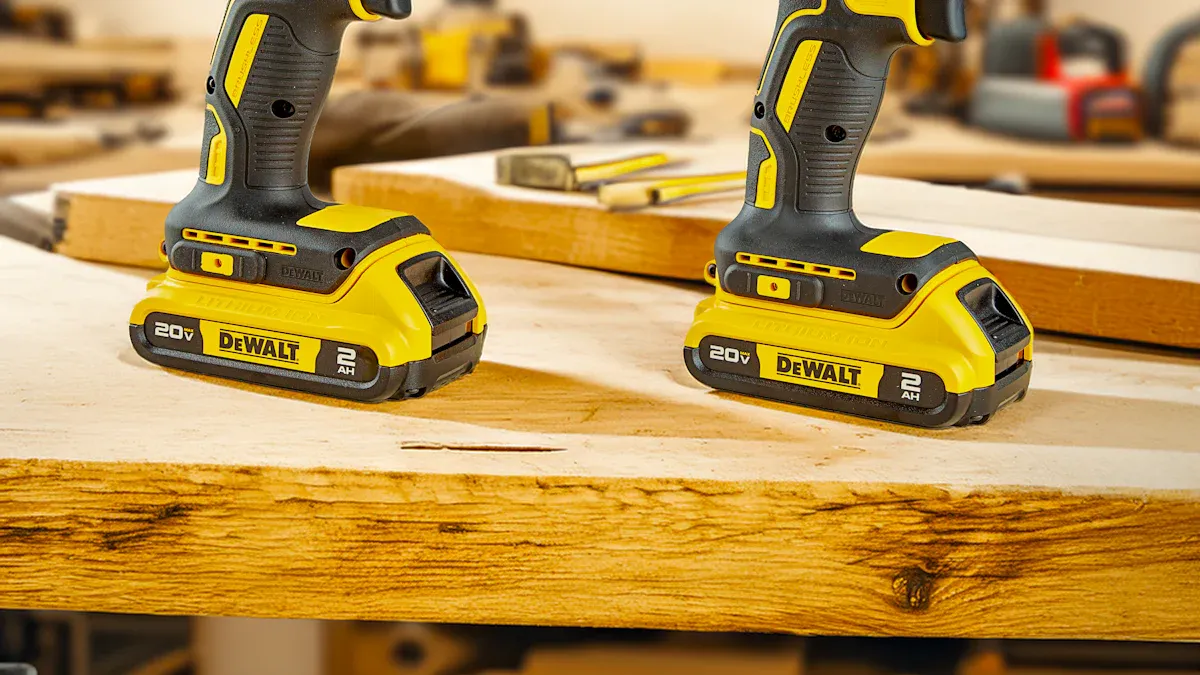A brushed motor is also called a brushed DC motor. It is an electric motor that uses direct current. It has brushes inside to keep the electricity flowing. The brushed DC motor has a rotor with coils that spin. It also has a stator with permanent magnets. The commutator and brushes change the current in the rotor windings. This helps the motor spin smoothly. Brushed motors use mechanical commutation. This makes them different from other motors. Many industries use brushed motors because they are simple. They are not expensive and work well. They are good for jobs that need strong turning power at low speeds. Brushed DC motors are used in electronics and machines.
Attribut
Brushed Motor Use Case
Market Position
Good for slow, strong, and cheap uses
Applications
Electronics, cars, factories, DIY projects
Key Benefit
Easy to use and not costly
Principaux enseignements
A brushed motor has brushes and a commutator. These parts send electricity to the spinning rotor. This makes the rotor turn and create power.
The main parts are the stator, rotor, commutator, and brushes. Each part helps the motor work.
Brushed motors are simple and not expensive. They give strong power at low speeds. This makes them good for many tools and machines.
These motors need regular care because brushes wear out. Worn brushes cause friction and can lower how well the motor works.
Brushed motors are good for easy jobs and DIY projects. But they are louder and use more energy than brushless motors.
Composants des moteurs à balais
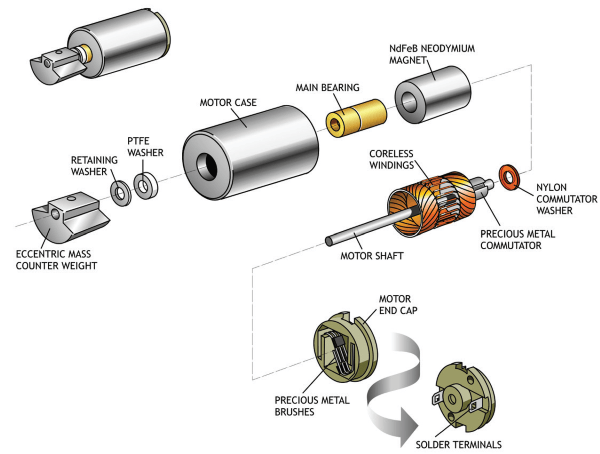
A brush dc motor has four main parts. These are the stator, rotor, commutator, and brushes. Each part does something important to help the motor work. The table below explains what each part does:
Composant | Function |
|---|---|
Stator | The stator stays still on the outside. It makes a magnetic field with windings or magnets. This field helps the rotor turn. |
Rotor | The rotor is also called the armature. It has windings that make a magnetic field when powered. This field works with the stator’s field to spin the rotor. |
Commutateur | The commutator is a copper ring on the rotor shaft. It switches the current direction by linking the rotor windings to the brushes. This lets the rotor keep spinning without extra switches. |
Brosses | The brushes connect to the DC power source. They touch the commutator and send current to the rotor windings. This makes a changing magnetic field for the motor to work. |
A brushed motor diagram shows these four parts clearly. Knowing about each part helps you see how a brush dc motor works.
Stator
The stator does not move in a brush dc motor. It makes a magnetic field that works with the rotor. Some brush dc motors use permanent magnets in the stator. These motors do not need extra windings or another power source for the field. This makes the motor simple and lets it react fast to voltage changes. The stator can also have wound coils. These coils help control speed and torque. In a brushed motor diagram, the stator is the outside shell.
Rotor
The rotor, or armature, sits inside the stator. It has windings that carry current. When current flows, the rotor makes its own magnetic field. This field pushes against the stator’s field and spins the rotor. The rotor’s design, like the winding type and materials, changes how much torque and speed the motor has. Some brush dc motors use a coreless rotor. This means there is no iron core, so the rotor is lighter and faster. Coreless motors are quiet, use less power, and start and stop quickly. These features are good for robots and small devices. A brushed motor diagram shows where the rotor is and what it looks like.
Commutateur
The commutator is a metal ring, often copper, on the rotor shaft. Its job is to change the current direction in the rotor windings. This keeps the rotor spinning the same way. The commutator works with the brushes to do this. Good commutators use copper, brass, or silver for better flow and longer life. Special coatings help cut down on friction and wear. You can spot the commutator in a brushed motor diagram because it links the rotor and brushes.
Brosses
Brushes in a brush dc motor are usually made of carbon or graphite. They press on the commutator and carry current from the power source to the rotor windings. Springs hold the brushes in place and keep them touching the commutator. The brushes slide as the rotor turns, making a moving electrical connection. This connection is needed for the motor to work. Brushes wear out but are easy to change. Their design helps the motor run quietly and smoothly. A brushed motor diagram shows the brushes touching the commutator.
Note: Coreless brush dc motors are fast, quiet, and react quickly. These features make them great for sensitive electronics and robots.
How Brushed DC Motor Works
Energy Conversion
A brush dc motor turns electrical energy into mechanical energy. When DC voltage is given to the motor, the brushes send current to the rotor windings. This current makes the coils active and forms magnetic poles on the rotor. The magnetic poles on the rotor work with the magnetic field from the stator. These forces pull and push, which makes the rotor spin. As the rotor spins, sometimes the commutator and brushes lose contact for a short time. The rotor keeps spinning because it has momentum until contact comes back. This way, the brush dc motor keeps changing electrical energy into movement.
The steps for energy conversion in a brushed motor are:
Electrical energy goes into the motor through the brushes and commutator.
The current in the rotor windings makes a magnetic field.
The rotor’s magnetic field works with the stator’s field and creates a force.
This force, called the Lorentz force, makes torque and spins the rotor.
The commutator switches the current direction at the right time to keep the rotor spinning.
The spinning shaft gives mechanical energy to run machines or devices.
Conseil : Fleming’s Left-Hand Rule helps show the direction of force and rotation in a brush dc motor.
Commutator & Brushes
Mechanical commutation is what makes a brushed dc motor special. The commutator is a metal ring with sections attached to the rotor. Carbon brushes press against the commutator and stay in touch as the rotor spins. As the rotor turns, the brushes slide over new commutator sections. This action switches the current direction in the rotor windings at the right time. The switch changes the magnetic poles of the rotor, so the torque keeps moving the same way. The brushes carry current from the power supply to the rotor through the commutator, finishing the circuit.
The commutator and brushes work together like this:
The commutator has metal sections connected to the rotor windings.
Brushes that do not move touch the commutator and give current from the power source.
As the rotor spins, the brushes move over new sections, switching the current direction in the windings.
This switching keeps the rotor’s magnetic poles changing, so the rotor keeps spinning.
The mechanical switching by the commutator and brushes is called mechanical commutation.
This system takes the place of electronic switches found in a brushless dc motor.
Mechanical commutation causes some energy loss in a brush dc motor:
Friction between brushes and commutator turns some energy into heat.
Sparking can happen if contact is not good, wasting energy as heat and light.
Brushes and commutator wear out and need regular care.
Component Interaction | Effect in Brushed Motors | Impact on Noise and Efficiency | Brushless Motor Advantage |
|---|---|---|---|
Brushes and Commutator | Physical contact causes friction, wear, sparking, and torque ripple | Makes mechanical noise, electrical noise, and lowers efficiency | Electronic commutation removes mechanical wear and noise, making efficiency better |
Electrical Contact | Carbon brushes give current through the commutator | More resistance and energy loss | No brushes, so less resistance and energy loss |
Maintenance | Needs regular care because of wear | Performance gets worse without care | Needs little care |
Noise Generation | Noise from friction and sparking | More sound and electromagnetic noise | Less noise because there are no brushes and commutator |
Operation Steps
A brush dc motor follows simple steps from power to movement:
Electrical power goes into the motor through carbon brushes that touch the spinning commutator.
The commutator sends current into the rotor coils and switches the current at the right times.
Current in the rotor coils makes a magnetic field.
The rotor’s magnetic field works with the stator’s field and makes torque.
The rotor spins, and the commutator and brushes keep switching the current direction to keep the rotor turning.
The motor shaft spins and gives mechanical energy to move a load.
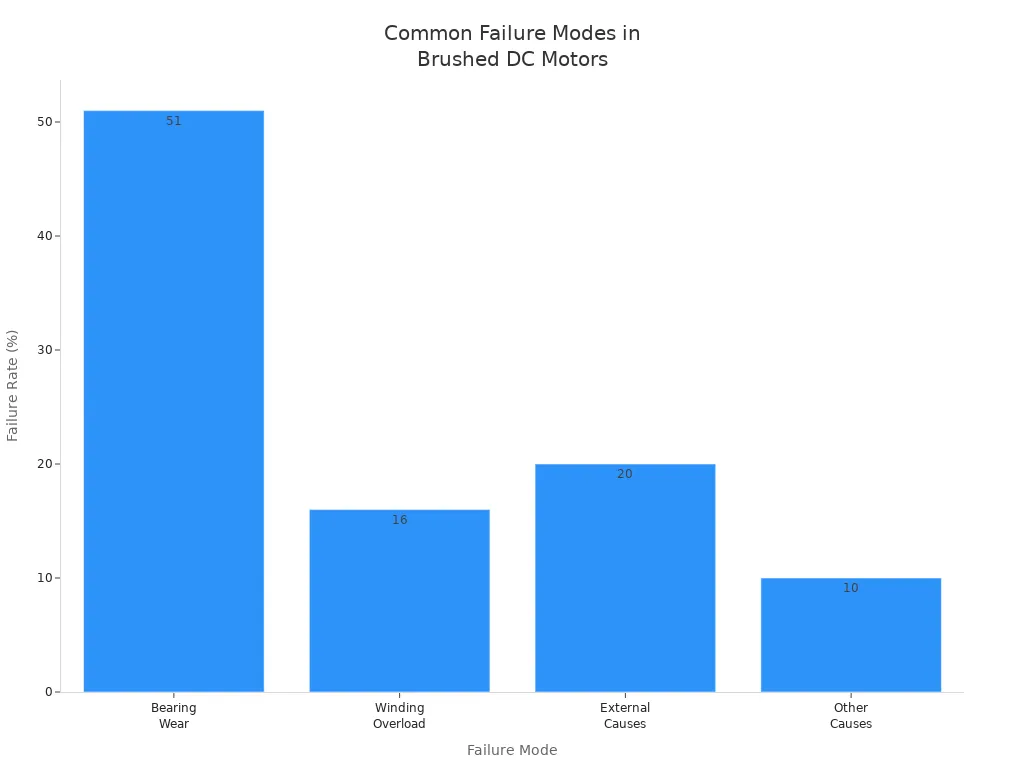
Common problems with a brushed dc motor are:
Overheating, which hurts insulation and windings.
Bearing wear, which causes friction and shaking.
Dirt or water getting in, which lowers efficiency.
Electrical problems like shorts or grounding issues.
Brush wear, which affects electrical contact and how well the motor works.
Checking and caring for the motor often helps stop these problems and keeps the brush dc motor working well.
What Is the Difference Between Brushless and Brushed DC Motors?
The difference between brushless and brushed dc motors is about how they switch current and how they work. The table below shows the main differences:
Aspect | Moteur à courant continu brossé | Moteur CC sans balais |
|---|---|---|
Commutation | Mechanical commutator and brushes switch current direction in rotor windings. | Electronic commutation using sensors and controllers switch current in stator windings. |
Maintenance | Needs regular care because brushes and commutator wear out. | Needs little care because there are no brushes or commutators. |
Durée de vie | Shorter life because of mechanical wear. | Longer life because there are fewer moving parts. |
Bruit et vibrations | More noise and shaking from brush friction and commutator contact. | Quieter with less shaking. |
Speed Capability | Works well up to about 10,000 RPM; limited by brush-commutator contact. | Can go faster, limited by rotor and bearing design. |
Efficacité | Lower efficiency because of friction and heat losses. | Higher efficiency because friction losses are gone. |
Contrôle | Simple control, no extra electronics needed. | Needs electronic controller and sensors for exact speed control. |
A brushless dc motor uses electronic switches instead of brushes and a commutator. This design makes the brushless motor work better, quieter, and last longer. Knowing the difference between brushless and brushed dc motors helps you pick the right motor for your job.
Brushed Motor Pros & Cons
Performance
Brushed motors work well in many machines. They give strong torque at low speeds. This helps when a job needs a lot of starting power. You can change the speed by changing the voltage. This makes it easy to control how fast the motor goes. The control system is simple and does not need fancy electronics. Brushed motors are good for jobs that need low or medium power. But they are not as efficient as brushless motors. When the load gets bigger, friction from the brushes wastes energy. The motor uses more current when it needs more torque. The most power comes between no load and stall. The table below lists important performance facts:
Métrique | Description |
|---|---|
Vitesse (tr/min) | Goes down when torque goes up; stops at stall torque |
Couple | Highest at stall; shows how much weight it can move |
Efficacité (%) | Best at low torque; drops when the load gets bigger |
Output Power | Most power happens between no load and stall |
Tip: Brushed motors are great when you need strong power and easy speed control.
Maintenance
Brushed motors need regular care to keep working well. The brushes and commutator wear out because of heat and rubbing. This makes the motor less efficient and shortens its life. You should change the brushes every 1,000 to 3,000 hours. Clean the commutator and check for dust to stop problems. Check the motor often and test it to find issues early. Keep extra brushes ready so you can fix the motor fast. Studies show brush wear is the main reason motors break. Using better parts and oil helps, but you still need to do maintenance.
Maintenance Task | Purpose and Frequency |
|---|---|
Brush Replacement | Change every 1,000–3,000 hours to keep it working well |
Commutator Cleaning | Clean often to stop dust from building up |
Electrical Tests | Find problems with wires or insulation |
Routine Inspections | Help the motor last longer and stop sudden breakdowns |
Coût
Brushed motors cost less to buy than brushless motors. Their simple build makes them cheap to make. This is good for people who need a motor for easy or short jobs. But you have to fix them more and replace them sooner. This makes the total cost higher over time. Maintenance costs add up, especially if you use the motor a lot. Brushless motors cost more at first because they need special controllers. But they last longer and need less fixing. Over ten years, you might spend more on a brushed motor because of repairs and downtime. If you care most about the first price, brushed motors are still a smart pick.
Brushed Motors DC Applications

Brushed motors dc are found in many things we use. They are simple and cheap. This makes them popular in lots of areas. The sections below show where these motors are used.
Électronique
Many electronics use brushed motors dc to make things move. These motors run small fans and CD or DVD drives. Electric toothbrushes also use them. Toys use brushed motors dc because they cost less and are easy to use. When you add voltage, the motors start spinning right away. You do not need extra parts to control them. This is why they are great for products made in large numbers.
Some electronics with brushed motors dc:
Battery toys
Portable fans
CD/DVD players
Small home appliances
Note: Brushed dc motors in electronics are used because they are cheap and easy to control.
Automobile
Cars use brushed motors dc in many places. These motors move power windows and adjust seats. They also run windshield wipers. Starter motors in cars use brushed motors dc for strong power in short times. The motors are small and work well. This is why cars have used them for many years.
Automotive Application | Role of Brushed Motors DC |
|---|---|
Power windows | Moves glass up and down |
Adjustable seats | Changes seat position |
Starter motors | Turns engine to start the car |
Windshield wipers | Moves wiper blades |
Modern cars can have many brushed motors dc. Each motor does a special job.
L'industrie
Factories use brushed motors dc because they are strong and easy to control. Steel mills and paper machines need these motors for steady movement. Cranes and hoists use them too. Power tools like drills and grinders have brushed motors dc. These motors do not need fancy controllers. They work well in machines that move in straight lines. This makes them important in factories.
Machines in industry with brushed motors dc:
Steel mills
Paper machines
Cranes and hoists
Power tools (drills, grinders)
Linear actuators
Robotics & DIY
Brushed motors dc are good for robots and DIY projects. They are cheap and easy to wire. People use them in small robots and model cars. Homemade gadgets use these motors too. You can change speed and direction by changing voltage or using simple circuits. Brushed motors dc give enough power for basic moves. If they break, you can replace them easily. For beginners and people on a budget, these motors are a smart pick.
Features for robotics and DIY:
Easy speed and direction control
Good power at low speeds
Simple to find and replace
Tip: Brushed motors dc let students and hobby fans build robots without spending a lot.
Brushed motors are still used in many areas. Their design is simple and they are easy to control. You can find them in cars, factories, electronics, and medical tools.
Some main pros and cons are:
They are built simply and do not cost much
They give strong power when starting and are easy to speed up or slow down
They are bigger and need more care because the brushes wear out
They make more noise and do not work as well as brushless motors
A brushed dc motor is a good pick if you want something cheap and easy to use.
FAQ
What causes brushes in a brushed motor to wear out?
Brushes wear out because they touch the commutator when the motor runs. This rubbing makes friction and heat. Over time, the brushes get smaller as bits break off. The dust from worn brushes can pile up inside the motor.
What is the main reason people choose brushed motors?
Most people pick moteurs à balais because they are simple and cheap. These motors are good for easy jobs. They are easy to control and have strong starting power.
What happens if a brushed motor runs without maintenance?
If you do not take care of a brushed motor, it will not work as well. Old brushes and a dirty commutator make bad electrical contact. The motor can get too hot or even stop working.
What is the typical lifespan of a brushed DC motor?
A brushed DC motor usually works for 1,000 to 3,000 hours. How long it lasts depends on how much you use it, how heavy the load is, and how well you take care of it.
